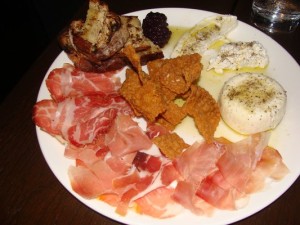An outbreak linked to raw sprouts in the U.S. that sickened 140 people occurred between November 2010 into 2011, involving sandwich franchise, Jimmy John’s (CDC, 2011; Illinois Department of Public Health, 2010).
The owner of the Montana Jimmy John’s outlet, Dan Stevens, expressed confidence in his sprouts claiming that because the sprouts  were locally grown they would not be contaminated, although the source of the contaminated sprouts had not yet been identified (KRTV, 2010).
were locally grown they would not be contaminated, although the source of the contaminated sprouts had not yet been identified (KRTV, 2010).
By the end of December 2010 a sprout supplier, Tiny Greens Farm, was implicated in the outbreak (Food and Drug Administration, 2010).
Jimmy John’s owner, John Liautaud, responded by stating the sandwich chain would replace alfalfa sprouts with clover sprouts since they were allegedly easier to clean (Associated Press, 2011c). However, a week earlier a separate outbreak had been identified in Washington and Oregon in which eight people were infected with salmonella after eating sandwiches containing clover sprouts from a Jimmy John’s restaurant (Oregon Department of Human Services, 2011; Terry, 2011). This retailer was apparently not aware of the risks associated with sprouts, or even outbreaks associated with his franchisees.
The FDA inspection of the Tiny Greens facility found numerous issues which may have led to pathogen contamination, including “the company grew sprouts in soil from the organic material decomposed outside without using any monitored kill step on it,” mold was found in the mung-bean sprouting room, and the antimicrobial treatment for seeds was not demonstrated to be equivalent to the recommended FDA treatment (Roos, 2011).
Months later, Bill Bagby Jr, owner of Tiny Greens, was quoted as saying “after the changes we made, it’s next to impossible for anything to happen,” hindering communication efforts by being defensive and overconfident (Des Garennes, 2011; Sandman & Lanard, 2011). Interestingly, Bagby also expressed confidence in sprouts following the German outbreak, commenting that for many like him, the nutritional  benefits outweigh the risk: “Sprouts are kind of a magical thing. That’s why I would advise people to only buy sprouts from someone who has a (food safety) program in place (that includes outside auditors). We did not have (independent auditors) for about one year, and that was the time the problems happened. The FDA determined that unsanitary conditions could have been a potential source of cross-contamination and so we have made a lot of changes since then.”
benefits outweigh the risk: “Sprouts are kind of a magical thing. That’s why I would advise people to only buy sprouts from someone who has a (food safety) program in place (that includes outside auditors). We did not have (independent auditors) for about one year, and that was the time the problems happened. The FDA determined that unsanitary conditions could have been a potential source of cross-contamination and so we have made a lot of changes since then.”
At a food safety meeting in Taiwan yesterday, attendees were, of course, served up a huge bowl of raw alfalfa sprouts.
Today, Fox 31 Denver learned exclusively, the Colorado Department of Public Health and Environment, the CDC and the FDA are all investigating an E. coli outbreak in the Denver metropolitan area.
In the second week of October three Jimmy John’s restaurants in the Denver Metro area reportedly served up sandwiches that sickened eight people with E. coli bacteria.
“We believe that their illness came from a produce item that was on those sandwiches that they ate,” said Alicia Cronquit, epidemiologist with the Colorado Department of Public Health and Environment.
Cronquist said all eight cases were reported between October 18th and 22nd, and all of the people impacted ate at Jimmy John’s between October 7th and 15th.
The Department of Public Health has not closed down the three restaurants, and will not identify their locations because Cronquist says they do not believe the restaurants are at fault.
“Our leading hypothesis for what’s happened is that there was a contaminated produce item that was distributed to the stores,” Cronquist said. “We have not identified any food handling issues at the particular establishments that we think would contribute to illness.”
A local teenager is among those still hospitalized from the E. coli in Denver. Family friends reached out to Fox31 Denver looking for answers as to why the public had not been notified. We took that question to state health officials and they told us it’s because the tainted food no longer appears to be a threat.
When contacted by Fox 31 News a Jimmy John’s corporate representative declined to comment on the outbreak.



.jpg) effectiveness.
effectiveness..jpg) with less health-endangering issues to correct theirs with less public notice. McDonald worked with the Colorado Restaurant Association for 18 months to create the new rules.
with less health-endangering issues to correct theirs with less public notice. McDonald worked with the Colorado Restaurant Association for 18 months to create the new rules. Officials believe it was caused by undercooking eggs — in particular for one specialty of the house. So far there are eight confirmed cases of salmonella and 20 listed as probable.
Officials believe it was caused by undercooking eggs — in particular for one specialty of the house. So far there are eight confirmed cases of salmonella and 20 listed as probable. Technically, the Ganja Gourmet is a medical marijuana dispensary, one of many that have sprung up this year throughout Colorado.
Technically, the Ganja Gourmet is a medical marijuana dispensary, one of many that have sprung up this year throughout Colorado..jpg) Specifically, contact with animals in the "Feed the Animals" exhibit on the third floor children’s area of the exposition center was probably where the outbreak originated, according to the extensive 15-page report.
Specifically, contact with animals in the "Feed the Animals" exhibit on the third floor children’s area of the exposition center was probably where the outbreak originated, according to the extensive 15-page report. Denver Broncos tight end Tony Scheffler
Denver Broncos tight end Tony Scheffler